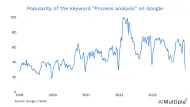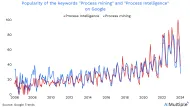What is Process Workflow & Top 4 Benefits & Case Studies in '24
“Process,” “workflow,” and “process workflow” are three concepts that are often used interchangeably, although they have different meanings. For an efficient process management and improvement, it’s important to distinguish one from the other.
Therefore, this research explores what process workflow is, why businesses need it, and why they should consider using process intelligence tool (e.g., process mining) or workflow management software.
Workflows vs. Processes
A process is designed to achieve a specific goal at the organizational level and can contain several workflows within it, such as invoice approval or registering a purchase order. These workflows are usually activities or tasks that are completed in a sequential order to obtain a business outcome.
There are three main workflow categories:
- Process workflow: These are predictable and repetitive sequence of tasks and steps.
- Case workflow: These tend to vary depending on the case.
- Project workflow: These are similar to process workflows with more flexibility in terms of when and how.
For example, an employee on-boarding process workflow defines the necessary information, policies and resources that new employees need to know.
Use a software to design and manage workflows
Workflows can be visualized with tools such as flowcharts and process maps. Flowcharts are simple geometric symbols and arrows, while process maps add support information on resources required at each step in the workflow.
Designing or modifying workflows on paper is an old method today since workflow diagrams or flowcharts are more robust and completed faster than before with the workflow management software and process intelligence tools.
For example, workflow management software can orchestrate the flows by coordinating the individual steps. The software can also provide templates for documentation and process modeling, which are important for successful business process management.
On the other hand, a process intelligence tool, such as process mining, can also help map the entire processes and zoom into the specific workflow or activity in a given workflow. It provides a model that relies on real-time process data, to assess performance, check compliance with internal and external rules, optimize and manage processes, and implement changes. Discover how process mining works, its use cases, and 11 benefits it offers.
The reasons why you need process workflows in your business include:
1. It improves your operations
Workflows can facilitate operation and boost efficiency.
Workflows define and illustrate the job steps, and establish clear start and endpoints for a process. Such visuals are easy to understand by everyone involved. Thus, they ensure that processes are formalized and executed according to the procedures and standards.
One example is a utility company from the Netherlands that applied process mining to map their complex purchase order process workflow and standardize the steps and activities.
2. It reduces repetitive activities
Simple workflow diagrams are helpful to identify redundant and repetitive tasks and activities which could ultimately result in a smoother and less wasteful process.
Workflow management can be useful to track the entire operation from the first point till the end. As a result, business analysts can implement changes to eliminate unnecessary steps, roles and actives, and improve workflow.
For example, a German company that benefited from process mining to visualize their entire production cycle workflow which covers the entire time that raw materials are received until they become the final product. With process mining, analysts identified and eliminated unnecessary and redundant steps in the workflow and shortened their throughput time by 30%.
3. It decreases operational cost
Workflow design and management reduce the cost occurring due to repetitive or unnecessary tasks by allowing analysts to track and eliminate them. With less expenses, companies can allocate their budget and resources more efficiently, while improving their operations.
For example, in a sales order process, receiving and placing the order is the first step in the workflow. In this step, employees are expected to collect all relevant information regarding payment, delivery address or personal details of the customer and ensure that the product the customer asks is in the stock and can be shipped and delivered on the expected time.
A confusion or repetition in the placing order workflow can prolong the entire process flow, increases costs and decreases customer satisfaction.
4. It discovers automation opportunities
A workflow can facilitate the discovery of automation opportunities by pinpointing the tasks that are repetitive or automatable. By automating the tasks, processes become smoother, and employees can generate time for more value-added activities. Automation also produces data that businesses can leverage to assess the process performance, level of risk for each changes to implement in operations and analyze trends.
In the sales order process mentioned above, the employee goes through each step in the workflow through their system which include ERP and CRM systems. These systems automate the sales order processes, which removes the paperwork for each single step that needs to be completed from the first order entry until the approval and delivery.
Read more on how process mining can facilitate your RPA journey and optimize the CRM, such as Salesforce, and ERP systems like SAP.
Further reading
Explore how process intelligence tools such as process mining can improve processes, help design, plan and manage processes or process workflows.
- 3 Steps to Follow for a Successful Process Planning
- 4 Technologies that Accelerate Process improvement
- 7 Best Practices for Business Process Design
Check out our data-driven process mining and workflow management software vendor lists to choose your tool and start managing your workflows.
Explore some other tools that can help workflow and process management such as:
Assess different vendors with a transparent methodology yourself by downloading our checklist:
If you still need more help, you can always contact us:



Comments
Your email address will not be published. All fields are required.